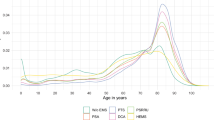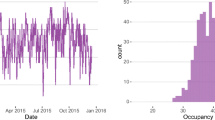Abstract
This paper aims to improve the performance of clinical processes using clinical pathways (CPs). The specific goal of this research is to develop a decision support tool, based on a simulation-optimization approach, which identify the proper adjustment and alignment of resources to achieve better performance for both the patients and the health-care facility. When multiple perspectives are present in a decision problem, critical issues arise and often require the balancing of goals. In our approach, meeting patients’ clinical needs in a timely manner, and to avoid worsening of clinical conditions, we assess the level of appropriate resources. The simulation-optimization model seeks and evaluates alternative resource configurations aimed at balancing the two main objectives—meeting patient needs and optimal utilization of beds and operating rooms.
Using primary data collected at a Department of Surgery of a public hospital located in Genoa, Italy. The simulation-optimization modelling approach in this study has been applied to evaluate the thyroid surgical treatment together with the other surgery-based CPs. The low rate of bed utilization and the long elective waiting lists of the specialty under study indicates that the wards were oversized while the operating room capacity was the bottleneck of the system. The model enables hospital managers determine which objective has to be given priority, as well as the corresponding opportunity costs.








Similar content being viewed by others
References
Porter ME (2010) What is value in health care? N Engl J Med 363:2477–2481
De Blaser L, Depreitere R, De Waele K, Vanhaecht K, Vlayen J, Sermeus W (2006) Defining pathways. J Nurs Manag 14:553–563
Panella M, Marchisio S, Stanislao F (2003) Reducing clinical variations with clinical pathways: do pathways work? Int J Qual Health Care 15:509–521
Aringhieri R, Tànfani E, Testi A (2013) Operations research for health care delivery. Comput Oper Res 40(9):2165–2166
Ozcan YA (2009) Quantitative methods in health care management: Techniques and applications, 2nd edn. Jossey-Bass/Wiley, San Francisco
Vissers J, Beech R (2005) Health operations management patient flow logistics in health care. Routledge, UK
H.H.R C, Bradshaw N, Porteous M (1998) Integrated care pathways. Br Med J 316:133–144
Rotter T, Kinsman L, James E, Machotta A, Gothe H, Willis J, Snow P, Kugler J (2010) Clinical pathways: Effects on professional practice, patient outcomes, length of stay and hospital costs (review). In: The Cochrane library 2010, issue 7. Sons, John Wiley &
Zander K (2002) Integrated care pathways: eleven international trends. Journal of Integrated Care Pathways 6:101–107
Cardoen B, Demeulemeester E (2008) Capacity of clinical pathways - a strategic multi-level evaluation tool. J Med Syst 32(6):443–452
Tanfani E, Testi A (2012) A decision support tool to analyze clinical pathways in hospital. In: Tànfani E, Testi A (eds) Advanced decision making methods applied to health services, series: International series on operations research and management science, 173. Springer-Verlang, Milano, pp. 191–211
Swisher J, Jacobson S, Jun J, Balci O (2001) Modeling and analyzing a physician clinic environment using discrete event-event (visual) simulation. Comput Oper Res 28:105–125
Vanberkel PT, Boucherie RJ, Hans EW, Hurink JL, Litvak N (2012) Efficiency evaluation for pooling resources in health care. OR Spectr 34(2):371–390
Cote MJ, Stein WE (2007) A stochastic model for visit to the doctor's office. Math Comput Model 45:309–323
Maliapen M, Dangerfield BC (2010) A system dynamics-based simulation study for managing clinical governance and pathways in a hospital. J Oper Res Soc 61(2):255–264
Xu D. (2010). Simulating on CIS based on petri-net. In Proceedings of the 2009 I.E. International Symposium on IT in Medicine and Education, pp. 1132–1135.
Michalowski W, Wilk S, Thijssen A, Li M (2006) Using a bayesian belief network model to categorize length of stay for radical prostatectomy patients. Health Care Manag Sci 9(2):341–348
Li W, Liu K, Li S, Yang H (2010) A semiotic multi-agent modeling approach for clinical pathway management. J Comput 5(2):266–273
Zhang Y, Liu K, Cui G (2008) Consensus forming in clinical pathway development: Norm based modeling and simulation. In: In: Proceedings of the 2008 international conference on computational intelligence for modelling control and automation, CIMCA, pp. 931–936
Wolf A (2008) Constraint-based modeling and scheduling of clinical pathways”, recent advances in constraints. Lect Notes Comput Sci 63:122–138
Vissers J, Adan I, Bekkers J (2005) Patient mix optimization in tactical cardiothoracic surgery planning: a case study. IMA J Manag Math 16(3):281–304
Gartner D, Kolisch R (2014) Scheduling the hospital-wide flow of elective patients. Eur J Oper Res 233(3):689–699
Fu MC (2002) Optimization for simulation: theory vs. practice. INFORMS J Comput 14(3):192–215
Pasupathy R, Henderson SG (2005) In: Perrone LF, Wieland FP, Liu J, Lawson BG, Nicol DM, Fujimoto RM (eds) A testbed of simulation-optimization problems, vol 2005, pp. 255–263
Fu M.C., Glover F.W., April J. (2005). Simulation optimization: A review, new developments, and applications. In: Kuhl M.E., Steiger N.M., Armstrong F.B.,. Joines J.A (eds.), Proceedings of the 2005 winter simulation conference, Piscataway, New Jersey, pp. 83–95.
De Angelis V, Felici G, Impelluso P (2003) Integrating simulation and optimization in health care center management. Eur J Oper Res 150:101–114
Zhang Y, Puterman ML (2013) Developing an adaptive policy for long-term care capacity planning. Health Care Manag Sci 16(3):271–279
Baesler F.F., Sepúlveda J.A. (2001). Multi-objective simulation optimization for a cancer treatment center. In: Proceedings of the 2001 Winter Simulation Conference, pp. 1405–1411.
Landa P, Tanfani E, Testi A (2013) Simulation and optimization for bed Re-organization at a surgery department. In: In: Proceedings of the 3rd international conference on simulation and modeling methodologies, technologies and applications, pp. 584–594
Lee EK, Atallah HY, Wright MD, Post ET, Thomas C IV, Wu DT, Haley LL Jr (2015) Transforming hospital emergency department workflow and patient care. Interfaces 45(1):58–82
Feili HR (2013) Improving the health care systems performance by simulation optimization. J Math Comput Sci 7:73–79
Ahmed MA, Alkhamis TM (2009) Simulation optimization for an emergency department healthcare unit in Kuwait. Eur J Oper Res 198(3):936–942
Ozcan YA, Tànfani E, Testi A (2011) A simulation-based modeling framework to deal with clinical pathways. In: Jain S, Creasey RR, Himmelspach J, White KP, Fu M (eds) Proceedings of the 2011 winter simulation conference. Piscataway, New Jersey, pp. 1190–1201
Ozcan YA, Tànfani E, Testi A (2013) Project Management approach to implement clinical pathways: An example for thyroid treatment. In: Zaric G (ed) Operations research and health care policy, series on operations research and management science, 190. Springer, Newton, pp. 91–104
Mullen PM (2003) Prioritising waiting lists: how and why? Eur J Oper Res 150(1):32–45
Testi A, Tanfani E, Valente R, Ansaldo G, Torre GC (2008) Prioritising surgical waiting list. J Eval Clin Pract 14(1):59–64
Valente R, Testi A, Tanfani E, Fato M, Porro I, Santori G, Santo M, Ansaldo GL, Torre GC (2009) A model to prioritize access to elective surgery on the base of clinical urgency and waiting time. BMC Health Serv Res 9(1). doi:10.1186/1472-6963-9-1
Witness 2014. Manual guide, Lanner Group.
Sargent RG (2013) Verification and validation of simulation models. J Simul 7:12–24
Kleijnen JPC (1995) Verification and validation of simulation models. Eur J Oper Res 82:145–162
Law M.A. (2007). Simulation Modeling & Analysis, 4th ed., McGraw-Hill.
Acknowledgments
The authors wish to thank the director and clinical personnel of the General Surgery Department of San Martino Hospital for providing data and helping with model implementation and face validation. All the authors participated in this study and acknowledge the support from the Italian Ministry of Education, University and Research (MIUR) under grant no. RBFR08IKSB - FIRB PROJECT.
Author information
Authors and Affiliations
Corresponding author
Rights and permissions
About this article
Cite this article
Ozcan, Y.A., Tànfani, E. & Testi, A. Improving the performance of surgery-based clinical pathways: a simulation-optimization approach. Health Care Manag Sci 20, 1–15 (2017). https://doi.org/10.1007/s10729-016-9371-5
Received:
Accepted:
Published:
Issue Date:
DOI: https://doi.org/10.1007/s10729-016-9371-5




